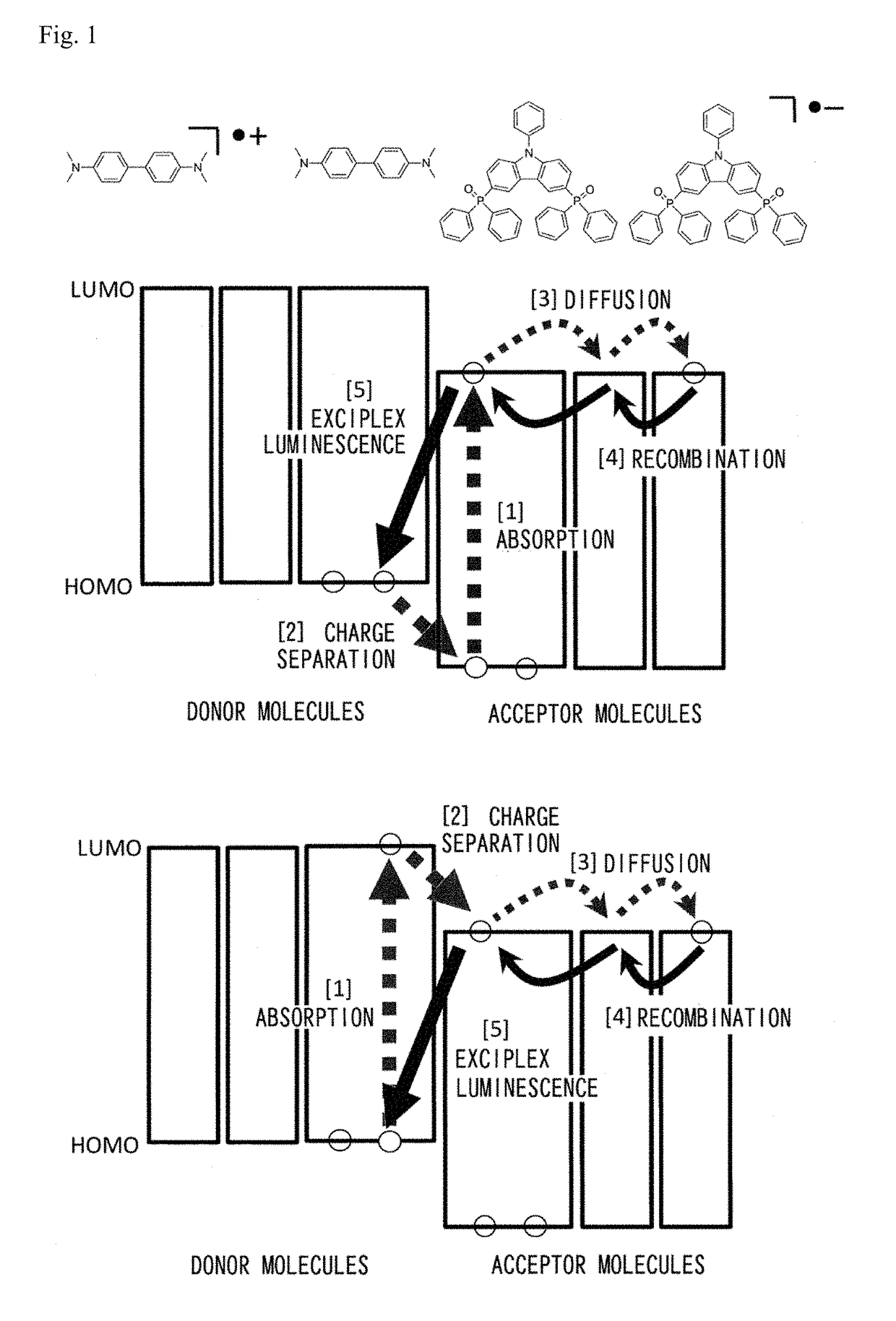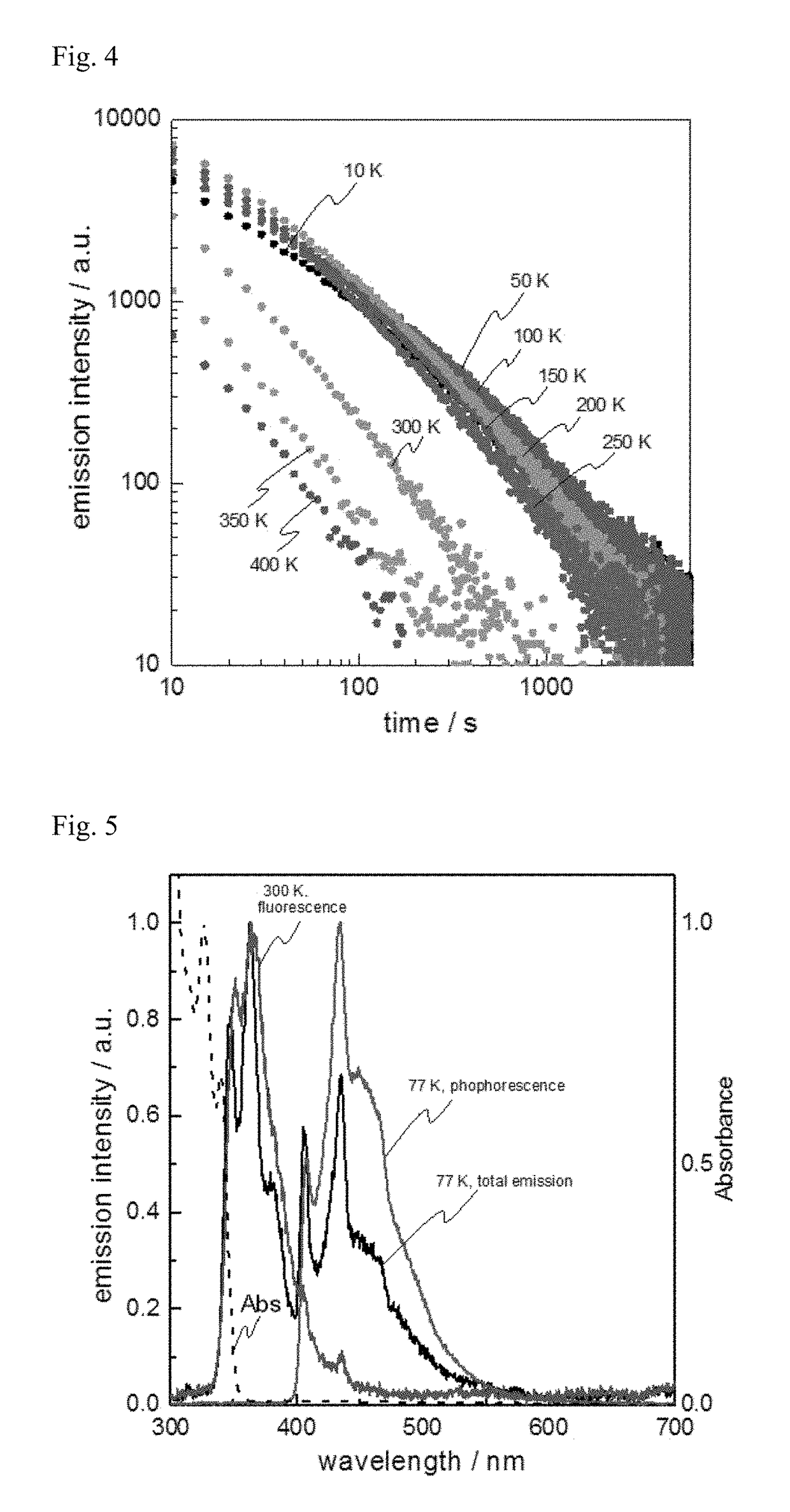Long Persistent Luminescence Emitter and Long Persistent Luminescent Element
a luminescent element and luminescence emitter technology, applied in the direction of luminescent compositions, chemistry apparatus and processes, etc., can solve the problems of difficult to obtain a uniform long persistent luminescent film, high production cost, and production steps, and achieve excellent long persistent luminescence properties and low cost
- Summary
- Abstract
- Description
- Claims
- Application Information
AI Technical Summary
Benefits of technology
Problems solved by technology
Method used
Image
Examples
example 1
n and Evaluation of Long Persistent Luminescence Emitters Containing PO2CzPh as the Electron-Accepting Molecule and TMB as the Electron-Donating Molecule
[0155]A quartz substrate was heated to a temperature of the melting point of PO2CzPh or higher (300° C. or higher) in a glovebox under a nitrogen atmosphere, and PO2CzPh was melted on the quartz substrate. TMB was added to and blended with the melted PO2CzPh at the concentration of 10 mol %, and the blend was cooled rapidly. A long persistent luminescent film in the glass state was thus formed and encapsulated using a glass substrate and an ultraviolet-cured resin. The ultraviolet absorption spectrum (Abs) of the produced long persistent luminescent film and its photoluminescence spectrum which was measured using excitation light of 340 nm at room temperature are shown in FIG. 2.
[0156]Separately from the film, a long persistent luminescent film of PO2CzPh and TMB was formed and encapsulated using a glass substrate and an ultraviolet...
experimental example 1
mpounds as Electron-Accepting Molecules
[0169]Long persistent luminescent films containing TMB at 10 mol % were formed and each encapsulated using a glass substrate and an ultraviolet-cured resin in the same manner as in Example 1 except that PO2CzH, DPEPO, PPT, 2CzPO, PyPO, P2CzPh, Estradiol, UGH3, mCP, mCBP or T2T was used instead of PO2CzPh and that the quartz substrate was heated to a temperature of the melting point of each compound or higher for melting the compound.
[0170]Excitation light of 340 nm was applied to the long persistent luminescent films containing PO2CzH, PPT, DPEPO or 2CzPO as the electron-accepting molecule, of the long persistent luminescent films produced in Experimental Example 1, and to the long persistent luminescent film produced in Example 1 at the temperature of 300 K for three minutes, and then the photo-irradiation was stopped. The changes in the emission intensity with time after that were measured. A log-log graph showing the changes in the emission ...
experimental example 2
mpounds as Electron-Donating Molecules
[0173]Long persistent luminescent films containing the electron-donating molecules at 10 mol % were formed and each encapsulated using a glass substrate and an ultraviolet-cured resin in the same manner as in Example 1 except that TPPD, TPA, PhCz, MeCz or mCP was used instead of TMB.
[0174]Excitation light of 340 nm was applied to the long persistent luminescent films produced in Experimental Example 2 at room temperature for three minutes, and then the photo-irradiation was stopped. The photographs of the long persistent luminescent films taken during the photo-irradiation and five seconds, five minutes and 20 minutes after the photo-irradiation stopped are shown in FIG. 10. The photographs in FIG. 10 are the photographs of the long persistent luminescent films containing the respective compounds indicated under the photographs as the electron-donating molecules, and for example, the photographs indicated by “TPPD” are the photographs of the lon...
PUM
| Property | Measurement | Unit |
|---|---|---|
| temperatures | aaaaa | aaaaa |
| persistent luminescence duration time | aaaaa | aaaaa |
| persistent luminescence duration time | aaaaa | aaaaa |
Abstract
Description
Claims
Application Information
 Login to View More
Login to View More - R&D
- Intellectual Property
- Life Sciences
- Materials
- Tech Scout
- Unparalleled Data Quality
- Higher Quality Content
- 60% Fewer Hallucinations
Browse by: Latest US Patents, China's latest patents, Technical Efficacy Thesaurus, Application Domain, Technology Topic, Popular Technical Reports.
© 2025 PatSnap. All rights reserved.Legal|Privacy policy|Modern Slavery Act Transparency Statement|Sitemap|About US| Contact US: help@patsnap.com



